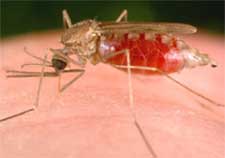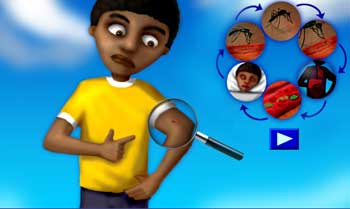The Infection Cycle
|
Photo courtesy of CDC. The malaria parasite is carried in the saliva of the female Anopheles mosquito. When the mosquito bites, the parasites move into blood stream, where they travel to the liver and multiply, making the person sick. The parasites remain in the blood stream, and are taken up with the blood when mosquitoes bite an infected person. In this way, malaria moves from person to person. |
Plasmodium falciparum, P. vivax, P. malariae, and P. ovale, the four parasites that cause malaria in humans, have a complex life cycle. They require both a human host and a mosquito host, and they pass through stages that involve sexual and asexual reproduction. Here’s how the infection cycle works.
A female Anopheles mosquito carries malaria parasites in her saliva. These parasites are in the form of sporozoites, a spore stage of reproduction for the parasite. When the mosquito bites a person, she injects the sporozoites into the blood. The sporozoites travel to the liver within about 30 minutes. Once there, each sporozoite starts to reproduce. They do this by developing into schizonts.
Each schizont contains thousands of merozoites (another stage of the parasite’s life cycle). The schizont matures in about five days, depending on the parasite species. It then ruptures, sending the merozoites into the bloodstream. The merozoites invade red blood cells, where they eat hemoglobin. Each merozoite then forms another schizont, creating more merozoites. When that second schizont matures, it ruptures the red blood cell, sending more merozoites into the bloodstream to invade more red blood cells. The rupturing of the blood cells causes the fever, chills, and other symptoms of malaria. This cycle of blood cell invasion and rupture continues until either the body’s immune system or antimalarial medicines bring the infection under control.
Life Cycle of the Malaria ParasiteThe malaria parasite must go through a number of different stages in its life. Follow the parasite as it moves from mosquito to human and back to mosquito. Click for animation. |
This all seems straightforward, but some of the merozoites don’t become schizonts. Some move into a sexual stage of reproduction, becoming male and female gametocytes. The gametocytes enter the person’s bloodstream. When a female Anopheles mosquito bites an infected person, she takes in the gametocytes. The gametocytes develop into spermlike and egglike gametes and fertilize into oocysts. The oocysts are filled with thousands of sporozoites. When the oocyst ruptures, the sporozoites move to the mosquito’s salivary glands, ready for the next bite.
In some cases the P. vivax and P. ovale sporozoites become hypnozoites. These can stay dormant in the liver for a long time—months or even years. When the hypnozoites reactivate, they cause a malaria relapse.
Now you understand how the Plasmodium parasites infect humans. Let’s find out how a malaria infection attacks the body.
This content has been re-published with permission from SEED. Copyright © 2025 Schlumberger Excellence in Education Development (SEED), Inc.



